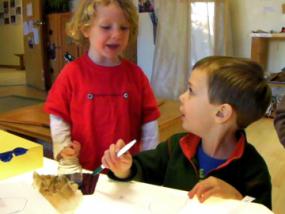That's not an N.... It's a W

This clip offers us a look at three pre-school-aged children, who are working to make “open” and “closed” signs for their dramatic play store. Sawyer (in red) coaches Mathew (writing the letters) on the sequence of the letters, beginning with “O.” For ‘P” he is careful to say both the name of the letter (i.e. “pee”) as well as the phonetic sound (“pppauu”). Mathew easily makes a circle for the letter “O” but needs some help with the letter “P.” We can admire the coaches attempts to be explicit, but even their combined descriptions cannot eliminate incorrect alternatives. Max says, “First a straight line, then a bubble.” Sawyer realizes this description is vague, so he adds, “…at the top.” Sawyer then breaks the action down into component marks, “Line down.” When he sees Matthew starting at the bottom Sawyer changes his instruction to, “Line up.” He realizes either way is okay. Matthew listens but makes what looks like a lollipop, a shape perfectly consistent with the instructions he has received. Sawyer realizes his own message needs some enhancement, so he offers a visual cue, tracing his finger where the half circle should go and adding, “No, it (the circle)) has to be on the line (implying that the circle should not be on top of the line). When Sawyer complains that Matthew’s second lollipop mark does not look like a “P” the teacher asks Sawyer to think about the exact wording he used, “You told him it was a circle with a line down.” In this instance the teacher is trying to help Sawyer mentally review his message to understand how Matthew’s drawing is, in a sense, accurate. Sawyer traces the half circle on the side of the straight line, but now Matthew has decided that his mark could be his “P.” Sawyer says, “I make my “P” like this (gesturing correctly). One wonders if the boys understand that a letter needs a conventional shape so that others will know it is a “P.” Matthew starts over and this time makes a “P” with the half circle on the side of the stem instead of the lollipop. “Good ‘P’ Matthew,” says Sawyer approvingly.
Again Matthew breaks the component actions down for the letter “A” instead of “E.” The teacher allows this inventive spelling for now, observing the process the boys use to instruct and follow one another. Mathew makes a clear “A” on his paper. But the children stumble in their collaboration yet again when Sawyer tries to verbally explain how to make the letter “N.” The teacher tries to help Sawyer recognize different strategies to explain his idea. Sawyer’s instructions of, “Up, down, up” do not specify that the “down” is on a diagonal. The teacher draws what she hears (three lines overlapping) in hopes that Sawyer will repair his message. Sawyer’s words carry less information than his gesture, so the teacher asks Matthew to watch Sawyer’s finger tracing the “N” in the air. Max joins the conversation by suggesting that Matthew look at the shape of an “N” that Mathew previously made for another sign. After starting again and making a well formed “O, P, and A” the troublesome “N” must be shaped. Matthew looks at his earlier “N” and, as most children do, he starts with a down stroke instead of an upstroke, which makes an inverted “N”, given that children do not think to lift their pencil before making the diagonal. But almost as if he knows his three line mark does not look like an “N” he adds another line so that the last three lines of his newly formed “W” does look like an italicized “N.” Regardless of the teacher’s support of Matthew’s attempt, Sawyer will have none of it and says, “That’s a W.” Nevertheless, the boys seem satisfied enough, and the sign goes on the front of their pretend store.
The teacher recognized that this experience was not only a learning experience for the child writing the letters, but also for the children trying to help him write. Thinking about one’s message from the perspective of the listener creates competent instructors. Questions: Does this clip give us any new ideas about how to support children by watching the ways they support one another? Do you think children are more willing to criticize and accept criticism from their peers than from adults?
